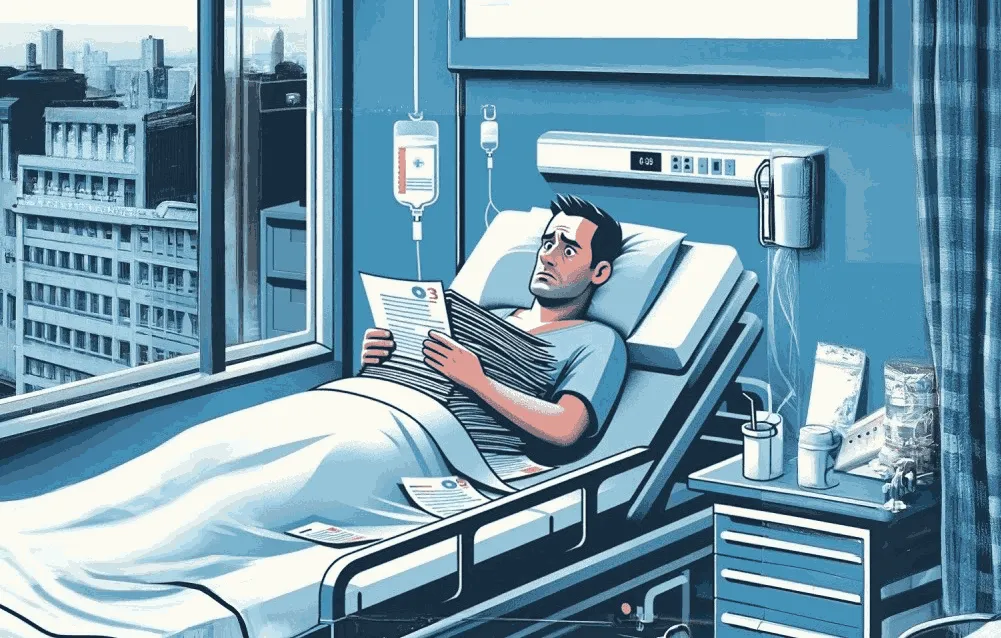The term "36 critical illnesses" covers a range of serious health problems that can greatly affect your life. These include things like cancer, heart attacks, strokes, and organ transplants, among others. Understanding these illnesses is important for anyone looking to stay fully protected. Get to know each of these illness below:
Cancer
Cancer is the uncontrolled growth of abnormal cells in the body, which can invade and destroy healthy tissues. It can occur in various forms (e.g., breast, lung, prostate). Treatments like surgery, chemotherapy, and radiation are expensive and can significantly impact a person's lifestyle. Recovery often requires long-term care, affecting one's ability to work and lead a normal life.
Heart Attack
A heart attack occurs when blood flow to part of the heart is blocked, causing damage to the heart muscle. This often leads to hospitalization, long recovery periods, and lifestyle changes such as dietary restrictions and reduced physical activity. In severe cases, it can also lead to long-term disability or death.
Stroke
A stroke happens when the blood supply to the brain is interrupted, causing brain damage. Strokes often result in physical and cognitive impairments, such as paralysis or speech difficulties, which require extensive rehabilitation and long-term care, severely affecting an individual’s independence.
Organ Transplant
Organ transplants involve replacing a failing organ (like the liver, heart, or kidney) with a healthy donor organ. The procedure is life-saving but requires lifelong immunosuppressive medication and regular monitoring, impacting quality of life and requiring significant medical expenses.
Kidney Failure
Kidney failure is when the kidneys can no longer filter waste from the blood. It requires either dialysis (an expensive and time-consuming treatment) or a kidney transplant. This condition can severely impact a person’s lifestyle, limiting mobility, diet, and overall health.
Coronary Artery Bypass Surgery
This surgery is performed to bypass blocked arteries in the heart, improving blood flow. Recovery can take months, and patients need to make major lifestyle changes, such as dietary modifications and increased physical activity, to prevent future heart problems.
Alzheimer's Disease
Alzheimer’s disease is a progressive brain disorder that leads to memory loss and cognitive decline. Over time, it impairs the ability to perform daily tasks and often requires full-time caregiving, placing a heavy emotional and financial burden on families.
Parkinson's Disease
Parkinson’s is a progressive neurological disorder that affects movement, causing tremors, stiffness, and difficulty with balance. As the disease worsens, it can lead to severe disability, requiring long-term care and altering the patient’s ability to live independently.
Multiple Sclerosis (MS)
MS is an autoimmune disease that attacks the nervous system, leading to muscle weakness, difficulty walking, and fatigue. Its unpredictable course and progression often require ongoing treatments, rehabilitation, and lifestyle adjustments, including mobility aids and assistance with daily activities.
Motor Neuron Disease (MND)
MND affects the nerves that control voluntary muscles, leading to muscle weakness, difficulty speaking, swallowing, and breathing. There is no cure, and it rapidly leads to significant physical disability, often requiring ventilators and other medical aids.
Paralysis
Paralysis is the loss of muscle function in part of the body, often resulting from a stroke, injury, or disease. Depending on the extent, it can severely limit mobility and independence, often requiring long-term rehabilitation and assistive devices.
Major Burns
Severe burns can cause lasting damage to the skin and tissues, requiring extensive medical care, including surgeries and rehabilitation. Recovery is often prolonged, with the potential for physical disabilities and emotional trauma.
Coma
A coma is a prolonged state of unconsciousness where the individual is unresponsive. It often results from severe head injuries or medical conditions and requires intensive medical care. Recovery can be slow, with possible long-term physical and cognitive impairments.
Blindness
Blindness is the loss of vision, which can significantly alter a person's lifestyle. It affects the ability to work, move independently, and perform daily activities, often requiring special training and assistive devices.
Deafness
Deafness is the complete or significant loss of hearing, which can impact communication and social interaction. Depending on the severity, it may require hearing aids or cochlear implants, along with learning alternative communication methods like sign language.
Loss of Speech
Loss of speech can occur due to a stroke, injury, or neurological disorder. It can severely impact a person’s ability to communicate and may require speech therapy and assistive communication devices.
Aplastic Anemia
Aplastic anemia is a rare condition where the body stops producing enough new blood cells, leading to fatigue, frequent infections, and uncontrolled bleeding. It often requires treatments like blood transfusions, medications, or bone marrow transplants.
Bacterial Meningitis
Bacterial meningitis is an infection of the protective membranes around the brain and spinal cord. It can cause severe complications, including brain damage, hearing loss, or death if not treated promptly.
Brain Tumor
A brain tumor can be benign or malignant and affects the brain’s functioning. Symptoms can range from headaches and seizures to cognitive decline, and treatment often involves surgery, radiation, or chemotherapy, impacting the patient’s quality of life.
Cardiomyopathy
Cardiomyopathy is a disease of the heart muscle, making it harder for the heart to pump blood. It can lead to heart failure, requiring long-term medication or a heart transplant, and drastically affects daily life.
End-stage Liver Disease
This is the final stage of chronic liver disease where the liver can no longer function properly. It requires extensive medical care, often leading to the need for a liver transplant, and severely impacts quality of life.
Heart Valve Replacement
This is surgery to replace a damaged heart valve. Recovery involves months of rehabilitation, and patients need to make significant lifestyle changes to prevent further heart issues.
Loss of Limbs
Losing a limb can occur due to an accident, illness, or surgery. It impacts mobility and independence, requiring prosthetics, rehabilitation, and emotional adjustment.
Loss of Independent Existence
This refers to the inability to perform basic daily activities without assistance, often due to aging or illness. It requires caregiving and can significantly affect one’s quality of life.
Major Organ Failure on Waiting List
Being placed on a waiting list for an organ transplant indicates critical organ failure (e.g., liver, heart, or kidney). This requires intensive medical care and often has a significant emotional and financial impact.
Primary Pulmonary Hypertension
A rare lung disorder that causes high blood pressure in the lungs' arteries, leading to heart failure. It requires lifelong treatment and often affects exercise capacity and daily activities.
Progressive Supranuclear Palsy
A rare brain disorder that causes problems with walking, balance, and eye movement. Over time, it leads to severe disability and requires full-time care.
Severe Lung Disease
Severe lung diseases, like COPD, cause breathing difficulties and limit physical activity. Oxygen therapy and other treatments are often required, and the condition significantly impacts daily life.
Systemic Lupus Erythematosus with Lupus Nephritis
Lupus is an autoimmune disease where the immune system attacks the body. Lupus nephritis specifically affects the kidneys, leading to kidney failure if untreated.
Third-degree Burns
These are severe burns that destroy the deepest layers of skin and tissue, requiring extensive medical care, including surgeries and long-term rehabilitation.
Viral Encephalitis
Viral encephalitis is inflammation of the brain caused by a virus. It can lead to long-term neurological damage, including memory loss, seizures, and cognitive impairment.
Benign Brain Tumor
A non-cancerous growth in the brain that can still cause serious health issues by pressing on critical areas, requiring surgery or radiation.
Chronic Liver Disease
Chronic liver disease gradually damages the liver over time. Without proper treatment, it can progress to liver failure, requiring lifelong care or a transplant.
Creutzfeldt-Jakob Disease
A rare, degenerative brain disorder that leads to rapid mental decline and movement issues. It is fatal, with no cure, and requires extensive care.
Fulminant Viral Hepatitis
This is a severe form of hepatitis that causes rapid liver failure. Treatment often involves intensive care and possibly a liver transplant.
Motor Neurone Disease with Permanent Symptoms
A progressive neurological disorder that causes muscle weakness and wasting. Permanent symptoms include difficulty speaking, moving, and breathing, leading to severe disability.
These conditions significantly affect a person's health, lifestyle, and future, often requiring extensive medical treatment, rehabilitation, and long-term care. Among the 36 critical illnesses, the most common ones include cancer, heart attacks, strokes, kidney failure, and major organ transplants.
Dealing with these conditions usually involves a lot of medical care, time in the hospital, and ongoing treatment, which can be really expensive and stressful for both you and your family. Critical illness insurance helps provide financial relief, ensuring that individuals and their families can focus on recovery without worrying about the financial burden.






















